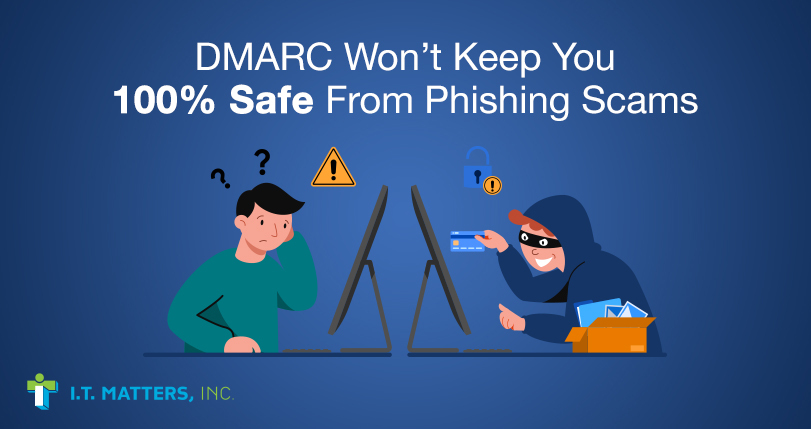DMARC is an effective and important defensive method, but don’t make the mistake of assuming it’s a silver bullet for phishers.
Phishing is one of the most common cybercrime threats active in the world today. It is extremely prevalent, as, at the start of last year, Google had registered 2,145,013 phishing sites, a drastic increase from 1,690,000 the year before.

Furthermore, the average phishing attack costs businesses $1.6 million. The problem with the rising tide of cybercrime incidents is that you get desensitized to the whole thing.
Lastly, the fact is that businesses aren’t learning to protect themselves, which is why the number of reported phishing attacks has gone up by 65% in the past few years, and by 47% in the first quarter of 2021 alone.
As phishers continue to develop their tactics and hone their skills, cybersecurity professionals race to keep up and introduce new defensive strategies and systems. One such defensive layer is DMARC, which many consider to be a key phishing defense…
What Is DMARC?
Domain-based Messaging, Authentication, Reporting, and Conformance (DMARC) is a key component of an effective cybersecurity strategy. It helps protect your organization’s email by automatically authenticating the sender of an email to verify it is coming from an authorized source. DMARC also provides visibility into malicious emails sent using forged “from” addresses, known as phishing attacks.
When you deploy DMARC for your domain, it will help check for any potential issues with incoming emails before they reach your users’ inboxes. This gives you greater control over which messages are allowed through and provides added protection against any malicious emails sent from unauthorized sources. Additionally, some DMARC policies can instruct receiving mail servers to delete emails that fail the authentication checks.
DMARC also provides reports that can help you monitor and detect malicious activity, such as phishing attacks. These DMARC reports provide information on any attempts to send email using your domain name, and any messages that were blocked or allowed through.
With this data, you can analyze email traffic patterns in order to spot potential threats and understand how attackers are attempting to use your domain name for malicious purposes, making it easier to take action where needed.
Overall, deploying DMARC is an important part of creating an effective cybersecurity strategy for your organization’s email system. It helps keep unauthorized emails from reaching users and provides data that can be used to better identify and respond to potential threats. By leveraging the power of DMARC, organizations can gain greater control over their email security and help protect against phishing attacks.
That said, DMARC is not infallible. Like any single layer of cybersecurity defense, it has its limitations…
Key Challenges Associated With Implementing DMARC
Opt-In
It’s important to note that DMARC only works when the spoofed brand has opted into the system. If a given brand hasn’t published DMARC, then the hacker in question can simply use them to spoof their way into their target’s good graces.
Technical Challenges
It’s worth noting that implementing DMARC (and deploying the necessary DKIM and SPF) is no small task. It requires expert personnel, time, and additional resources to manage properly. Not every small business is going to be able to facilitate this process easily.
Two Potential Vulnerabilities
Lastly, it needs to be stated that DMARC is not a perfect system for addressing phishing. In fact, it is vulnerable to two key attack vectors:
“Close Cousins”
In the world of online deception, close cousins to display name spoofing use a blend of ingenuity and manipulation to deceive their targets. Close cousin email addresses appear identical to legitimate ones, but with subtle differences that often go unnoticed at first glance. Some may contain additional or fewer characters, while others may incorporate Cyrillic characters that are difficult to spot.
Furthermore, some may include extensions, such as company, .co, .global, or .ca, making it difficult for even the most vigilant recipients to distinguish them from the real thing. These tactics demonstrate the lengths to which cybercriminals will go to deceive their targets and highlight the importance of remaining constantly vigilant against such practices.
Display Name Spoofing
In this method, a cybercriminal manipulates the sender field to display a fabricated name or alias that resembles a real email address or organization name. By doing so, the hacker creates an illusion of legitimacy and trustworthiness to lure the recipient into opening the email and potentially falling prey to their malicious intentions.
This technique is often used in phishing attacks, where a cybercriminal aims to obtain sensitive information or spread malware via email. It is vital to stay cautious and scrutinize emails, especially if they appear suspicious or unsolicited.
AI Can Augment Your Phishing Defenses
The combination of Natural Language Processing (NLP) and Computer Vision technology can effectively identify and monitor fraudulent phishing and spear phishing emails. NLP, which relies on advanced AI algorithms, focuses on comprehending and analyzing the meaning of text. Through text clustering, NLP seeks to establish relationships among textual data and identify recurring patterns for the identification of phishing language, content, and style.
By leveraging these cutting-edge technologies, organizations can facilitate the detection of security threats, mitigate the risks of email-based attacks, and protect their valuable assets from harmful effects. These modern solutions represent a significant step forward in the fight against cybercrime and present reliable means to safeguard sensitive data and information.
In the realm of combatting spear phishing, NLP technology has proven to be quite effective. Due to the challenge of analyzing text-only emails and recognizing their true intent, NLP has emerged as a powerful solution. This technology can easily detect when an email is requesting sensitive information, such as account credentials or requesting a wire transfer. Additionally, anomaly detection algorithms can identify suspicious emails that have a high likelihood of being fraudulent.
This is accomplished by identifying any anomalies or inconsistencies, such as email addresses that don’t match the authorized addresses set within the organization’s system. By utilizing NLP and anomaly detection together, the gaps left open by signature-based detection techniques can be filled. Moreover, these methods are able to analyze the behavior, patterns, and text of each email in detail, allowing them to more accurately detect spear phishing attempts.
Phishing attacks are a serious threat that can be difficult to detect, especially when they use a spoofed email address. However, one effective countermeasure is to implement URL scanning using machine learning algorithms.
These algorithms work in real-time, scanning every URL that a user clicks on to detect any potential phishing attempts. By doing so, they can quickly identify obfuscation techniques like URL redirects and shorteners, as well as any other malicious behaviors that might be present on a phishing page.
This is an essential tool for any organization that wants to keep its employees safe from cyberattacks. Even if an attacker manages to get past initial email filters, URL scanning provides an extra layer of protection that can detect threats before they can do any harm.
Need Help With Your Phishing Defenses?
Implementing defenses like DMARC and AI-assisted tools allows companies to stay one step ahead in the ongoing battle against cybercrime. It is a proactive approach that can prevent attacks from ever getting off the ground, which is far more effective than simply reacting to security breaches after they have already occurred.
For expert assistance, get in touch with the I.T. Matters team today.

Would you like to reduce frustrations with technology and boost operational efficiency within your business? The I.T. Matters team partners with companies of various sizes to help you create a secure, scalable, and flexible technology infrastructure.
Exceptional customer service is at the foundation of everything we do – ensuring that IT projects fully align with your business goals. Our friendly and knowledgeable team continually reviews industry trends and government regulations to help reduce risk and create a more productive IT environment for your business. Whether you are looking for full-service, outsourced IT infrastructure support, or simply need help with an upcoming technology project, contact us to help!
